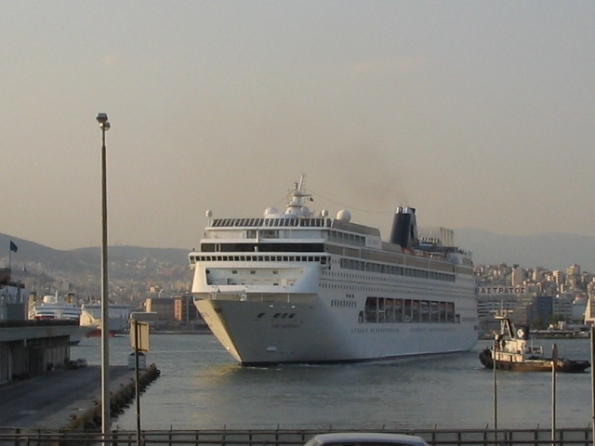 What will the next generation of cruise ships be like? Is the Ultra Voyager setting the bar for the next generation of ships? Cruise Industry News surveyed analysts, travel agents, designers and class societies about what kinds of ships they would like to see and what is possible to build.
What will the next generation of cruise ships be like? Is the Ultra Voyager setting the bar for the next generation of ships? Cruise Industry News surveyed analysts, travel agents, designers and class societies about what kinds of ships they would like to see and what is possible to build.
From a financial perspective size is king, according to Scott Barry, equity research analyst at Credit Suisse First Boston.
Tim Conder, vice president and senior leisure analyst at A.G. Edward & Sons, agreed: “From a pure financial point of view, bigger ships offer more amenities and more onboard spending opportunities. But if ships get too big, size can hurt the desirability of cruising, forcing the lines to lower prices,” he added.
“The bigger the ships, the more amenities they can offer,” said Bob Simonson, leisure analyst at William Blair & Company. “The bigger ships are eliminating many of the reasons why people will not cruise,” he pointed out.
CIBC World Markets Director of Equity Research Apurva Shah took a middle-of-the road approach: “We think the ultimate design should translate into strong pricing power and repeat business.”
Shah noted, however, that “larger ships can offer more amenities, more elegant cabins and more opportunities for passengers to upgrade to higher priced accommodations.”
Continued Conder: “The ships may get a little bigger, but unless people like a lot of exercise, bigger ships may have to feature monorails to accommodate passengers moving about.
“Most people want to get away from a lot of people when they go on vacation,” he added, noting, however, that the cruise lines aree good at not making passengers feel they are with more than 3,000 others aboard the big new ships.
Added Simonson: “I think future generations of ships will be a measure not only of financial people seeking to please investors, but also by people with foresight who will recognize that they can go broke in the future by being so profitable now. They realize they have to continue to develop the product.”
Simonson thinks the ownership of both the big companies mitigates any concerns about shortsightedness. “Both recognize that their assets have a long life,” he said. “This business lends itself to long-term planning, and the owners are in it for the long haul.”
Looking forward, Simonson said he does not think rock climbing will be as attractive as baby boomers get older, and he can foresee smaller, more intimate ships. He also sees future ships that discourage children, although he would not necessarily want to aboard a ship full of gray haired passengers – “looking like a place where people are waiting to die.”
Simonson also thinks that there will be more longer cruises, but sees a problem: “The rooms have barely enough storage space for three or four days’ worth of clothing. Closet space is a bigger problem than somebody walking in and asking where is the rest of the room?” he said.
How much bigger ships can get will also depend on the infrastructure ashore, according to Barry, who is convinced that the mass market is where the money is.
The lines must balance the all-inclusive concept versus what they are offering now, according to Conder, who said the lines must be careful not to change too much. “People expect certain standards,” he explained. “When you get off the plane, you do not want to run a gauntlet of people hawking stuff every time you turn around. But you do not need to be totally all-inclusive either.”
Barry expects to see more co-branding and opportunities for passengers to buy out of the all-inclusive. “People are used to drinking Starbucks,” he said, “and more than happy to pay for it. They are willing to pay more for value added features.
“A lot of travel agents say that the lines are nickel and diming passengers, but the true all-inclusive feature is still there for those who want it. But most people are willing to spend more,” Barry added.
Meanwhile, the slower building pace gives cruise lines the opportunity to hike prices, although Barry wondered if too much of a hike could upset the industry’s value proposition. So far, cruising offers a tremendous value proposition vs. land-based vacations, he said.
Added Simonson: “This year, per diems are about the same for Carnival and Royal Caribbean as in 2000. While cruises cost the same, the value has gone up, compared to prices in Las Vegas and at Disney World that are way up. . .”
With fewer disruptions in demand and with a slowdown in new capacity being introduced, Simonson expects yields to go up. As that happens, he thinks it would be prudent for the cruise lines to ease up on what they charge for onboard.
Shah sees both pros and cons in the slower building pace. “The overall thesis is that decelerating capacity growth bodes well for pricing,” he said. “But the significant margin upside will be muted by losing out on economies of scale.” He added that the slower pace, which allow for improved pricing, could also translate into slower earnings as unit growth will slow down as the ability to hike prices matures.
The newbuilding pace depends on a number of moving parts, according to Conder, of which the dollar-euro exchange rate is one. “If it cracks and drops to 1.10, you will see orders picking up,” he predicted. “I think the plans are in place,” he added. “The cruise lines are just waiting.” – Oivind Mathisen
Excerpt from the Cruise Industry News Quarterly Magazine: Fall 2004




